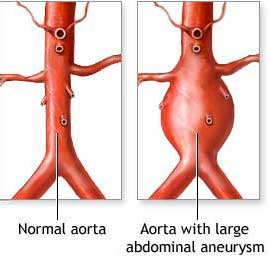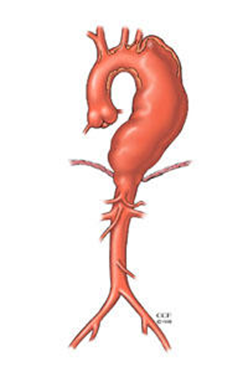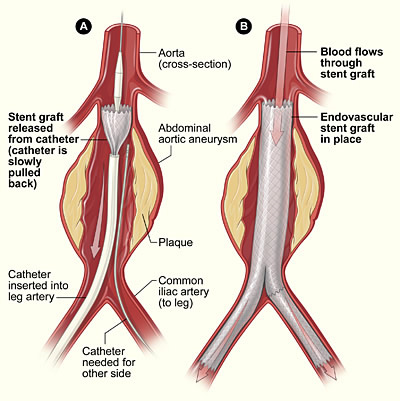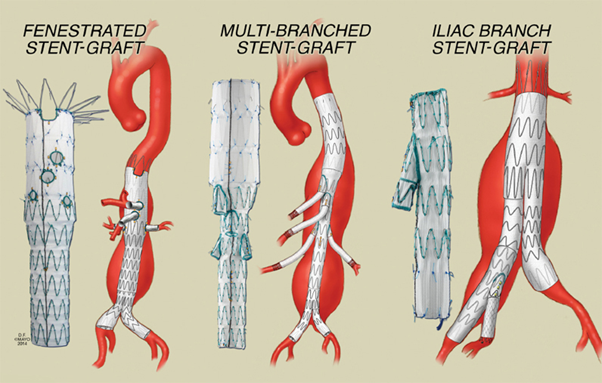What is an aneurysm?
An aneurysm is a condition where the wall of the artery became weak and bulges in size, much like a balloon. An aneurysm is diagnosed when the size of the bulge is greater than 150% the size of its normal adjacent segment. Aneurysm can affect any artery in the body. The most common location for aneurysms are in the following order:
- Thoracic aortic aneurysm
- Abdominal aortic aneurysm
- Popliteal aneurysm
- Visceral artery aneurysm
The aorta is the largest artery in our body. It carries blood from the heart to the different organs in the body providing them with nutrients and oxygen. The aorta arises from the heart and then runs through the chest and abdomen giving off branches along the way to supply the organs inside the chest (heart/lung/oesophagus) and abdomen (liver, kidney, gut, spleen). In the abdomen the aorta divides into two branches (iliac artery) and this continue on into the legs as the leg artery (femoral artery).


Figure 1: Abdominal aortic aneurysm and thoracic aortic aneurysm
Risk factors for aneurysm
- Aging- more common in elderly population
- Smoking
- High blood pressure- uncontrolled blood pressure often result in aortic dissection resulting in weakness in aortic wall, predisposing to thoracic aneurysm development
- Atherosclerosis- hardening and narrowing of the arteries
- Family history- other family members with aneurysm or died of aneurysm rupture
- Trauma- motor vehicle accident, high impact fall
- Infection- syphilis (a sexually transmitted infection) used to be a common cause for thoracic aneurysm
- Inflammation- such as giant cell arteritis and Takayasu arteritis
- Genetic disease affecting the connective tissue of the body- such as Marfan syndrome, Loeys-Dietz syndrome, Ehlers-Danlos syndrome, and Turner syndrome. These people develop aneurysm at a younger age and are at a higher risk of dissection and rupture
Complications of aneurysm
- Rupture – causes internal bleeding and may lead to death
- Embolization – dilated part of the artery have slow blood flow near the wall and therefore blood clot tends to form in these areas and some of the clot can become dislodge and travel down the artery and get lodged in other organs depriving those organs of nutrients and oxygen
Symptoms of aneurysm
- No symptom at all – this is most commonly the case
- Prominent pulse in the abdomen
- Sudden collapse – this is an emergency (dial 000 and ask for an ambulance and take to nearest emergency department)
- Pain – this indicate that the artery wall is stretching – need to attend the nearest emergency department
- Pain and discoloration of the toes – sign of embolization (blood clot blocking the blood supply to the legs). This is also an emergency.
- Pressure symptom from the aneurysm- such as hoarse voice and difficulty with swallowing food for thoracic aneurysm and flank pain in abdominal aortic aneurysm
Diagnosis
- CT angiogram- this provide accurate information on the size and anatomy of the aneurysm and helps with surgical treatment planning
- Ultrasound – this can be used to diagnose and monitor abdominal aortic aneurysm

Figure 2: Reconstructed CTA images of abdominal aortic aneurysm
Indications for treatment
- Large size of aneurysm – >5cm in abdominal aortic aneurysm (AAA) and >6cm in thoracic aneurysm. Patient with >5.5cm AAA are not allowed to drive. Aneurysm between 3-5 cm, requires regular monitoring with ultrasound or CT scan, usually every 6-12 months. Smaller aneurysm are not repaired due to risk of complication from aneurysm less than risk of surgery
- Symptomatic- pain, embolization
- Rupture
Treatment
Open surgical aneurysm repair
The surgeon makes an incision in your abdomen and replaces the weakened part of your aorta with a synthetic tube called an aortic graft. This graft is usually made of Dacron, or Gortex, the same materials that are used to manufacture some of our clothing. The strong synthetic tube replaces the weak segment of the aorta and allows blood to flow through it. This is a big operation and patients are required to stay overnight in the intensive care unit and then 4-6 days on the ward. Complete recovery from the operation may require 6 weeks to 6 months depending on patient fitness prior to the surgery. Open aneurysm repairs are successful in over 90% of the cases without the need for further intervention for the long term.
Potential complications of open AAA repair
- Heart attack
- Irregular heart rhythms
- Bleeding during or after surgery
- Injury to the bowel or loss of blood flow to the bowel
- Loss of blood flow to legs or feet from a blood clot
- Blood clot in the leg vein and lungs
- Infection of the graft
- Lung problems such as chest infection or collapsed lung
- Kidney damage
- Spinal cord injury- 1/400 paraplegia rate
- Death 5%
- Impotence for younger male patient

Figure 3: Open repair of abdominal aortic aneurysm
Endovascular stent graft
Endovascular stent graft repair of aortic aneurysm is a newer procedure compared to open repair of aortic aneurysm. It has been used to repair aortic aneurysm in the last 20 years, and in the recent years the technological advances has allowed increasingly complex aneurysm to be treated with the endovascular approach. In this approach, the repair is done through the femoral artery in the groin, requiring only two small cuts in the groin. The repair of the aortic aneurysm is done from inside the artery using wire, balloon and catheter (long thin tubes) that are threaded through the femoral arteries in the groin. X ray and contrast dye are used to guide the stent graft (fabric on a self-expanding metal tube) to the correct location. The endovascular stent graft once inside the artery behave similar to the synthetic graft that is sewn into the artery in open surgery and strengthen the weakened part of the artery. Recovery from the endovascular repair is much faster compared to open surgical repair, generally requiring only 2-3 days of hospital stay and intensive care stay is not required. This procedure however requires long term monitoring to ensure proper functioning of the stent graft. 20% of people who have endovascular repair of aortic aneurysms may require further intervention to maintain proper functioning of the stent graft. Most of these repeat procedures are also minimally invasive in nature.
Potential complication of endovascular repair of AAA
- Kidney damage
- Loss of blood flow to leg or feet from a blood clot
- Groin wound infection
- Groin hematoma (large blood-filled bruise)
- Bleeding
- Endoleak – continual flow of blood outside of the graft. Type II endoleak is the most common and does not require treatment unless the size of the aorta continues to increase. Other type of endoleaks will require further assessment and treatment
- Heart and lung problems
- Stent graft infection
- Spinal cord injury (very rare)
- Death 1%

Figure 4: Endovascular repair of abdominal aortic aneurysm

Figure 5: Repair of complex aortic aneurysm using fenestrated and branched stent graft